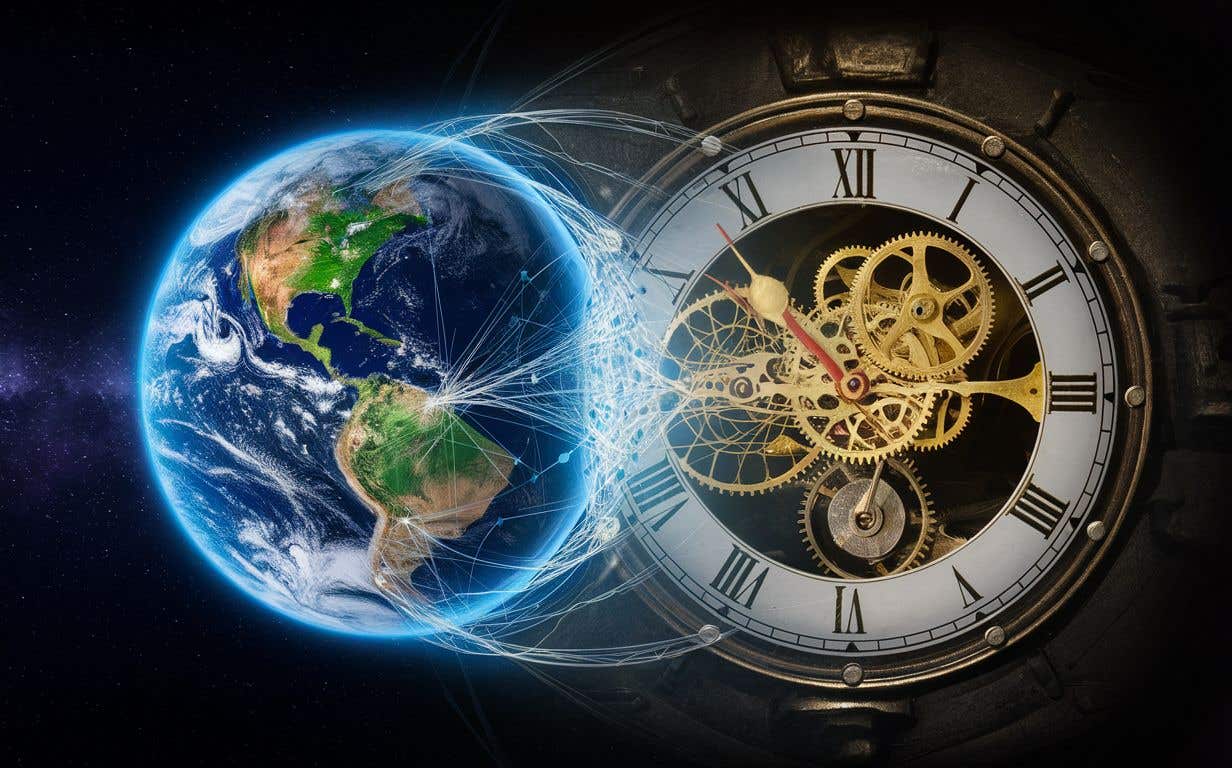Physicists discover that time may be an illusion born from quantum entanglement
A new study challenges the idea that time flows independently, rather suggesting that time only appears when quantum systems interact.

Long treated as a basic part of the universe, time may instead be an illusion—a side effect of quantum entanglement. (CREDIT: CC BY-SA 4.0)
Physicists are rethinking time itself. Long treated as a basic part of the universe, time may instead be an illusion—a side effect of quantum entanglement. A new study challenges the traditional idea that time flows independently. Instead, it suggests that time only appears when quantum systems interact in certain ways.
Published in Physical Review A, the study revisits a lesser-known theory from 1983 called the Page and Wootters (PaW) mechanism. This approach treats time not as a fixed backdrop but as something that arises from the properties of quantum systems. The theory turns time into a quantum observable rather than a built-in dimension.
Physics and Time
One major problem in physics is how differently time behaves in two major theories. In quantum mechanics, time acts like an outside ruler—it stays constant and doesn’t exist within the system being studied. Instead, it’s used to track change from the outside. This setup creates a paradox: how can time control change if it doesn’t actually exist inside the quantum system?
On the other hand, Einstein’s theory of general relativity describes time as flexible. Time stretches and bends depending on speed and gravity. For example, time runs slower near a black hole. This means time is not fixed but flows differently depending on where and how it’s observed. The conflict between this view and quantum mechanics has long puzzled scientists, who call it the “problem of time.”
Alessandro Coppo from the National Research Council of Italy puts it plainly: “It seems there is a serious inconsistency in quantum theory. This is what we call the problem of time.” This mismatch stands in the way of creating a single theory that explains all of physics—from the smallest particles to the entire cosmos.
Quantum Time Emergence Framework
To address this, the researchers took a fresh look at the PaW mechanism. According to this theory, time doesn’t exist on its own. It arises through entanglement between two quantum systems: one acts as a clock, the other as the system being measured. Without this relationship, time disappears completely, and the universe becomes motionless—a frozen snapshot without any flow.
Related Stories
- New study reveals that noise can strengthen quantum entanglement
- Researcher breakthrough creates extended quantum entanglement between molecules
- Noise can boost quantum entanglement instead of destroying it
To test the theory, they used a model with two entangled but separate quantum systems. One system—a vibrating harmonic oscillator—represented the evolving world. The other—a group of tiny magnetic spins—acted as the clock. The oscillator changed over time, not because of some outside force, but due to its entanglement with the clock. This matched the predictions of the Schrödinger equation, which describes how quantum systems evolve.
This new view marks a huge change in how we think about time. It suggests that time isn’t something we move through, like a road. Instead, it may be a product of quantum relationships. In a universe without entanglement, time may not exist at all.
Bridging the Quantum-Classical Divide
The researchers took their study further, applying the PaW mechanism to larger, macroscopic systems. By assuming that either the magnet clock or the harmonic oscillator was a classical object, they found that their equations naturally simplified into those used in classical physics. This suggests that the classical flow of time emerges from entanglement, even at larger scales.
“We strongly believe that the correct and logical direction is to start from quantum physics and understand how to reach classical physics, not the other way around,” Coppo said.
This finding supports the idea that classical physics emerges from quantum mechanics rather than existing as a separate framework. It also suggests that time itself may not be fundamental but instead a byproduct of quantum correlations.
Implications and Future Challenges
While this perspective is mathematically consistent, physicists remain cautious. Some researchers argue that, although the PaW mechanism offers an intriguing explanation, it lacks direct experimental validation.
“Yes, it is mathematically consistent to think of universal time as the entanglement between quantum fields and quantum states of 3D space,” said Vlatko Vedral, a professor of quantum information science at the University of Oxford. “However, no one knows if anything new or fruitful will come out of this picture—such as modifications to quantum physics and general relativity, and corresponding experimental tests.”
Experimental evidence remains the ultimate test of this theory. To truly determine whether time emerges from entanglement, physicists will need to design experiments capable of measuring these effects in real-world systems.
Despite the uncertainties, some believe this approach could be a step toward a deeper understanding of time. Adam Frank, a theoretical physicist at the University of Rochester, suggests that time might only make sense when viewed from within a system, rather than as a detached, objective phenomenon. “Maybe the only way to understand time is not from some God’s-eye perspective, but from the inside, from a perspective of asking what is it about life that manifests such an appearance of the world,” he said.
If the concept of time as an emergent property proves correct, it could lead to breakthroughs in quantum gravity and even reshape our understanding of reality. However, until experiments confirm these ideas, time’s true nature remains one of physics’ greatest mysteries.
More About the Page and Wootters (PaW) Mechanism
The Page and Wootters (PaW) mechanism, proposed by Don Page and William Wootters in 1983, offers an intriguing solution to the long-standing "problem of time" in quantum mechanics and quantum gravity. Traditionally, quantum mechanics describes time as an external parameter, while general relativity treats it as a dynamic, relational quantity embedded within spacetime itself. PaW reconciles these views by suggesting that time emerges entirely from entanglement and correlations between quantum systems, rather than existing as an absolute or independent background entity.
In the PaW approach, the entire universe is described by a timeless quantum state—often called the "wavefunction of the universe"—that is static and unchanging at the global level. Within this timeless framework, what we perceive as time arises solely through internal correlations between subsystems. One subsystem acts as a quantum "clock," with other systems evolving in relation to its states. Time, therefore, does not flow externally but emerges naturally from conditional probabilities linking different quantum states to specific "clock" readings.
This mechanism elegantly addresses fundamental conceptual challenges. By treating time as relational, PaW aligns closely with the relativistic notion of time as observer-dependent. It also resonates with quantum entanglement theory, as correlations between states underpin both entanglement and the emergence of time itself. However, PaW requires the presence of an appropriate quantum subsystem to act as a clock, raising practical questions about what constitutes a suitable quantum clock system and how accurately such a system can track emergent dynamics.
Despite its theoretical elegance, PaW faces ongoing scrutiny and debate within the physics community. Critics point out the difficulty in defining universally applicable quantum clocks and express concern about PaW's ability to describe the classical experience of time in realistic physical situations.
Nevertheless, recent advances in quantum information theory, entanglement research, and experimental proposals involving quantum reference frames and clocks have renewed interest in PaW. These developments continue to position the mechanism as a compelling framework for exploring the deep interplay between quantum mechanics, entanglement, and the nature of time itself.
Note: Materials provided above by The Brighter Side of News. Content may be edited for style and length.
Like these kind of feel good stories? Get The Brighter Side of News' newsletter.



